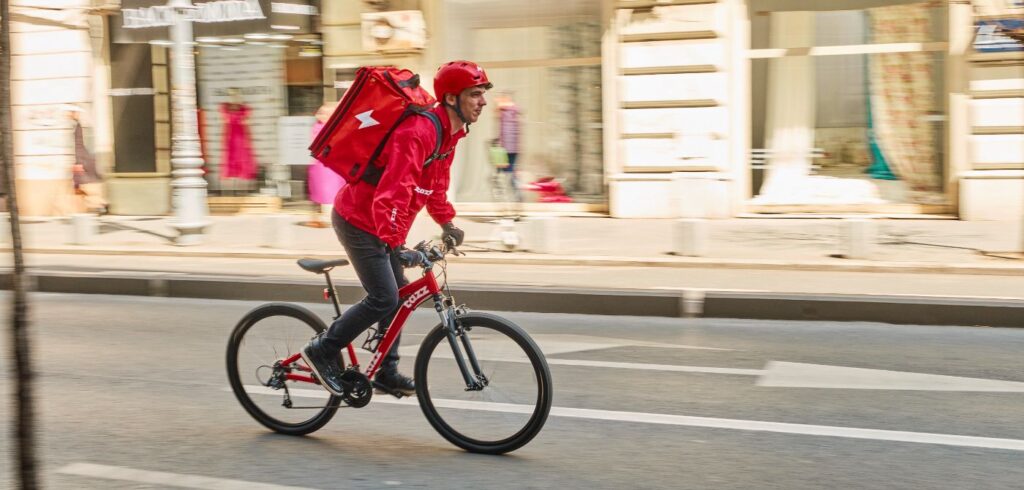Fresh delivery saw a surge during Covid as people were forced to stay at home and use or trial delivery of groceries, ready meals or hot direct-from-restaurant food. Since then, there has been much debate about the feasibility of this form of q-commerce (quick commerce).
Sector overview and a word on economics
The majority of fresh or even grocery delivery is still on-demand restaurant (or sometimes dark kitchen) products. In most markets, this probably still represents some 75% or more of all volumes. The remaining volumes are shared between grocery – ‘fresh’ and ‘pantry’ type products, to use Amazon terminology. Many players seek to supplement pantry volumes with non-food products to help improve the economics.
Indeed, economics is arguably still the greatest woe for this sector. High profile ultrafast delivery startups Getir and Gorillas are dramatically paring back their non-operational people assets. The reason for this is that large e-commerce players, especially Amazon, have educated customers to expect on-demand bespoke last-mile services for a low cost or even for free. Consumers don’t get to understand the real cost of the services and while the e-commerce behemoth is able to cross-subsidise the last mile with other revenues, not everyone is able to do so.
Talking to industry experts such as Martin Piechowski, president of Chronopost in France, or Alin Serban, CEO of Tazz in Romania, it seems that even with highly efficient and dense infrastructure, allowing four deliveries per driver hour, the cost of each delivery is at least US$5 and even more in some geographies. Matters are aggravated by a pandemic- and war-driven shortage of goods, and higher raw materials costs. When we add increasing delivery fees (to subcontractors or own drivers), and marketing and stock keeping costs, this becomes untenable.
Piechowski sums it up: “This is a difficult market segment where customer expectations are high and prices are often below an economically viable level. Only those who can master their operations and offer the right customer experience can survive.”
The situation is likely to be aggravated due to inflation and increasing interest rates that have significantly increased the monthly mortgage expenses of many families. Such pressure on household budgets is already causing a shift of spending to cheaper alternatives and promotions, so customers are even less likely to accept an additional delivery fee or higher prices that cover delivery costs. In this economically difficult time, only the players who are financially able to subsidise their fresh delivery business for long enough to build scale and awareness will be able to survive in the long term.
Which market segments are expected to grow?
Restaurant delivery will probably still grow fastest as a fallout from the Covid-related boom in this space. Grocery orders are generally much bigger than restaurant-related ones but there are several times fewer orders. A major issue here is the consumers’ need to see and touch fresh product and ensure it is the right type and quality.
In some markets, we are seeing an emergence of meal (healthy food) subscriptions, and this could well be an opportunity. In particular, the last-mile economics work better here due to standardized routes and repeat deliveries to the subscribers. And because this is usually unattended, in-night delivery, it is much easier to do.
Can we change the economics?
Sooner or later, to make this work, the fresh last mile will need to be served by robots…and renowned drone sceptic Ian Kerr will be pleased to know that we mean robots (AGVs) and not airborne drones! Interim solutions using autonomous vehicles are being tested by companies such as Naspers, and at Last Mile Experts we believe that this could be a good interim solution in which a driver is no longer necessary and the ‘courier’ can focus on preparing for their route and leave the vehicle to manage traffic, parking and find the best drop-off and collection point.
What are the key success factors in this market?
Operationally, the company must be totally reliable: best-in-class IT and operations are key to achieving the right customer experience. The provider must be able to offer a seamless service throughout the chosen geography. More than in any other last-mile segment, on-demand operators need to be tech driven. In addition, the brand should have credibility (ideally via a strong owner such as Amazon, eMag or LaPoste) and be supported by judicious marketing activities.
Execution of consistent and high-quality service is particularly important when it comes to food because this is one of the most emotionally charged categories of e-commerce. You will not get a second chance if you fail to deliver on customer experience once and leave your customer hungry… and angry!
Finally, the secret sauce is without doubt a team of experienced and motivated management and staff. We should never forget that the true brand ambassador, though, is the courier delivering the product; they are the only touchpoint with the customer. Indeed, staffing is becoming a key issue, but as Alin Serban states, “The better the brand and the vibe, the easier it is to get and retain staff.”
 Kasia Kazior is an experienced e-grocery executive with a strategy management background. She has built two e-commerce businesses and led a successful turnaround case of an e-grocery business.
Kasia Kazior is an experienced e-grocery executive with a strategy management background. She has built two e-commerce businesses and led a successful turnaround case of an e-grocery business.

Marek Różycki is managing partner at Last Mile Experts, specializing in CEP and e-commerce last-mile advisory.


